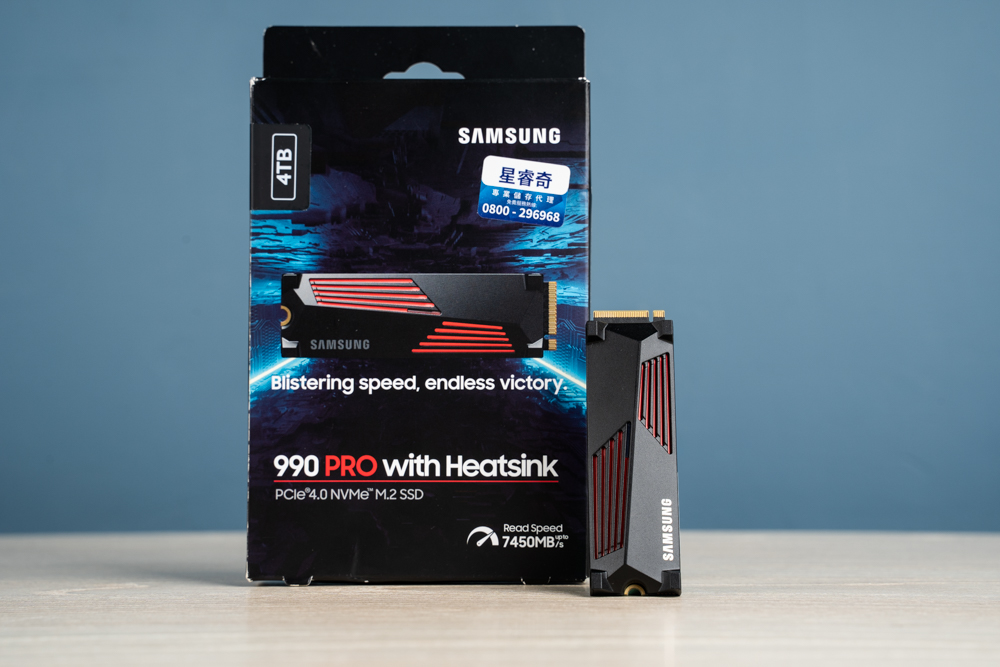
The Samsung 990 Pro with Heatsink is captivating PC enthusiasts’ wallets with its top-notch performance. This SSD boasts an innovative gaming-style heatsink integrated with RGB lighting effects, which can be customized using Samsung’s Magician software. Its robust metal heatsink is not only efficient for strong cooling but also perfectly suitable for expanding the PS5 console, enhancing the gaming setup. Moreover, it offers solid protection with a warranty of five years or 600TBW, whichever comes first.
Specifications at a glance:
- Interface: PCIe 4.0 x4, ensuring fast data transfer rates.
- NVMe: Version 2.0, for higher efficiency and performance.
- Form Factor: M.2 2280, compatible with a wide range of devices.
- Capacity Options: Available in 1TB, 2TB, and 4TB, catering to various storage needs.
- Controller: Samsung Pascal, for reliable and fast data processing.
- NAND Flash Type: 176-layer 3D V-NAND TLC, offering high density and reliability.
- DRAM Cache: LPDDR4-1866 1GB (per 1TB), enhancing the speed and performance.
- Dimensions: 80 x 22 x 3.2mm, a compact size for easy installation.
- Weight: Just 9.0g, lightweight yet durable.
- Power Consumption: 55mW (idle) / 5.5W (average) / 8.5W (peak), efficient for energy saving.
- Software: Samsung Magician Software, for easy management and customization.
- Warranty: 5 years or 600TBW limited warranty, providing peace of mind.
This SSD is a game-changer for both casual gamers and hardcore PC enthusiasts, blending high performance with stylish aesthetics and reliable durability. Whether upgrading a PC or expanding a PS5 console, the Samsung 990 Pro with Heatsink is a top-tier choice that promises to elevate your computing experience.
Samsung 990 PRO Review: A Leap in SSD Performance and Style with Pascal Chip and Heatsink Design
The Samsung 990 PRO SSD sets a new benchmark with its exclusive Pascal controller chip, manufactured using Samsung’s advanced 8nm process. This SSD supports PCIe 4.0 x4 and NVMe 2.0, delivering a remarkable 55% improvement in random read/write performance while significantly reducing power consumption compared to its predecessor, the 980 PRO. It features Samsung’s latest 7th generation 174-layer V-NAND TLC flash memory, with each 512GB chip designed for low power consumption. Available in 1TB, 2TB, and 4TB capacities, it offers flexibility for various storage requirements.
The 990 PRO with Heatsink version, which we are unveiling, comes equipped with a metal heatsink designed in a dual-sided sandwich style. This not only enhances its thermal efficiency but also adds an aesthetically pleasing touch with distinctive red lines that accentuate its gaming style. Moreover, it features built-in RGB lighting that can be customized via the SAMSUNG Magician software, allowing users to personalize their setup to match their style.
This SSD is a powerhouse, combining cutting-edge technology with energy efficiency and stylish design. Whether it’s for gaming, content creation, or heavy-duty computing tasks, the Samsung 990 PRO with Heatsink is engineered to meet the demands of modern computing, ensuring high performance, durability, and a touch of personalization with its RGB lighting.
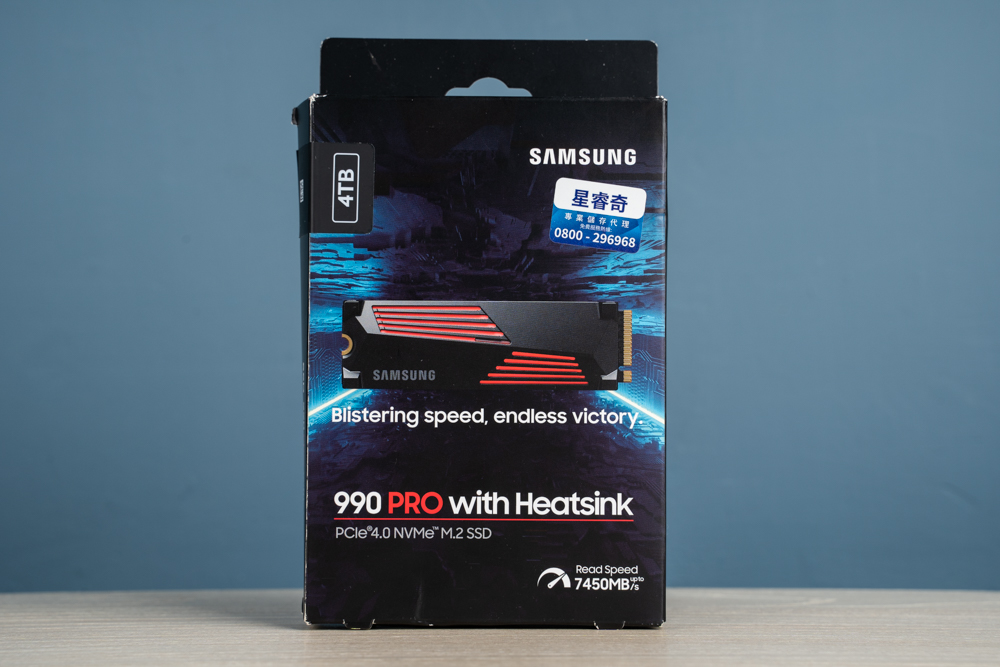
The box’s sleek and eye-catching design matches the high-speed, high-performance nature of the product. It prominently displays the “4TB” capacity, indicating this is the largest available storage option for this model. The packaging also features a striking image that pairs well with the product’s theme of speed and performance, hinted by the tagline “Blistering speed, endless victory.” The text “990 PRO with Heatsink PCIe 4.0 NVMe M.2 SSD” clearly informs potential buyers about the key specifications and the noted read speed of “7450MB/s” is prominently showcased, highlighting its swift performance. The overall presentation suggests that this SSD is targeted toward users who are looking for top-tier, competitive performance in their computing tasks.
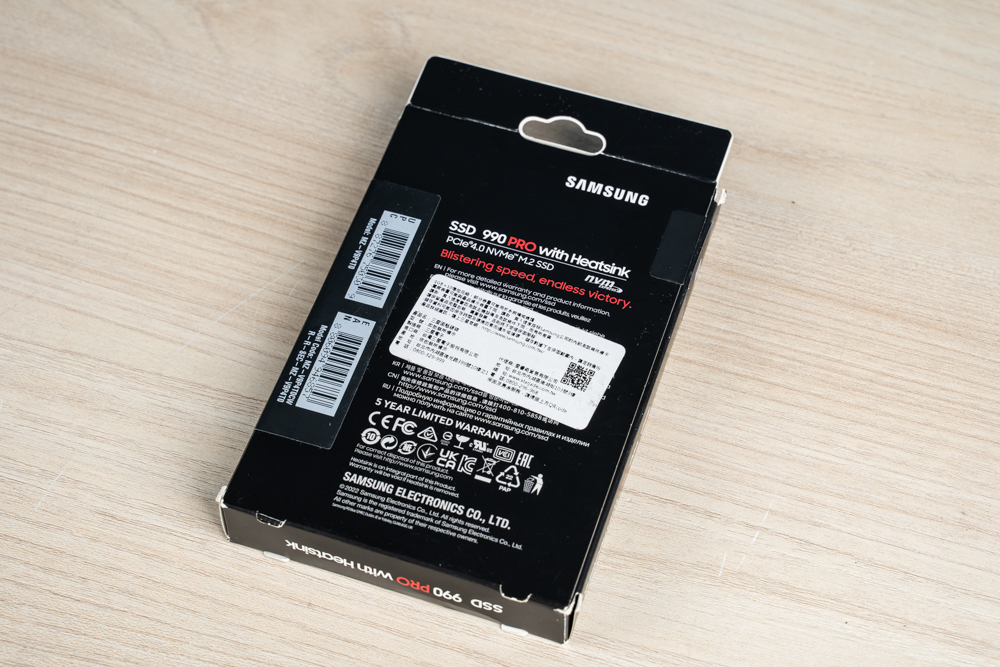
This is the back of the Samsung 990 PRO with Heatsink SSD’s packaging. It features a collection of various certifications and symbols that are important for consumers and regulatory bodies. A barcode and QR code can be scanned for additional information, likely directing to product details or registration. The packaging repeats the product name and its boastful tagline for brand continuity, and there’s also a clear indication of the “5-Year Limited Warranty”, reinforcing the manufacturer’s commitment to product quality and customer satisfaction.
The array of symbols includes the CE marking, which indicates conformity with health, safety, and environmental protection standards for products sold within the European Economic Area and other globally recognized certifications. There’s also a RoHS (Restriction of Hazardous Substances) symbol, meaning that the product complies with this directive in the EU that restricts the use of certain hazardous materials in electronics and electronic equipment. The presence of these symbols is crucial as they assure safety, quality, and environmental friendliness.
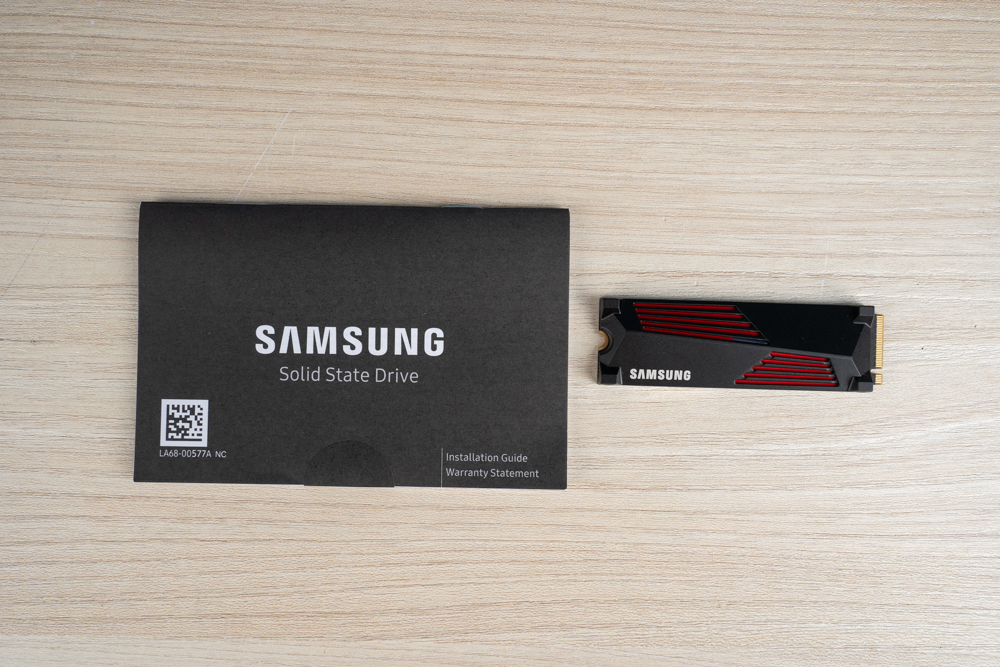
The physical Samsung SSD alongside its accompanying documentation. The SSD boasts a sleek design with the iconic Samsung branding and red accent lines that convey a sense of speed and performance, consistent with its gaming-oriented design. The heatsink is clearly visible, a crucial feature for maintaining optimal temperatures and ensuring peak performance during intense operations.
Next to the SSD is the installation guide and warranty statement, which are essential for users to correctly install their new hardware and understand the terms of their warranty. The document’s black design with white lettering matches the SSD, giving the product a cohesive and professional appearance and its associated materials. The QR code on the documentation likely links to detailed installation instructions or additional support resources online, giving users easy access to the information they need to get started with their new SSD.
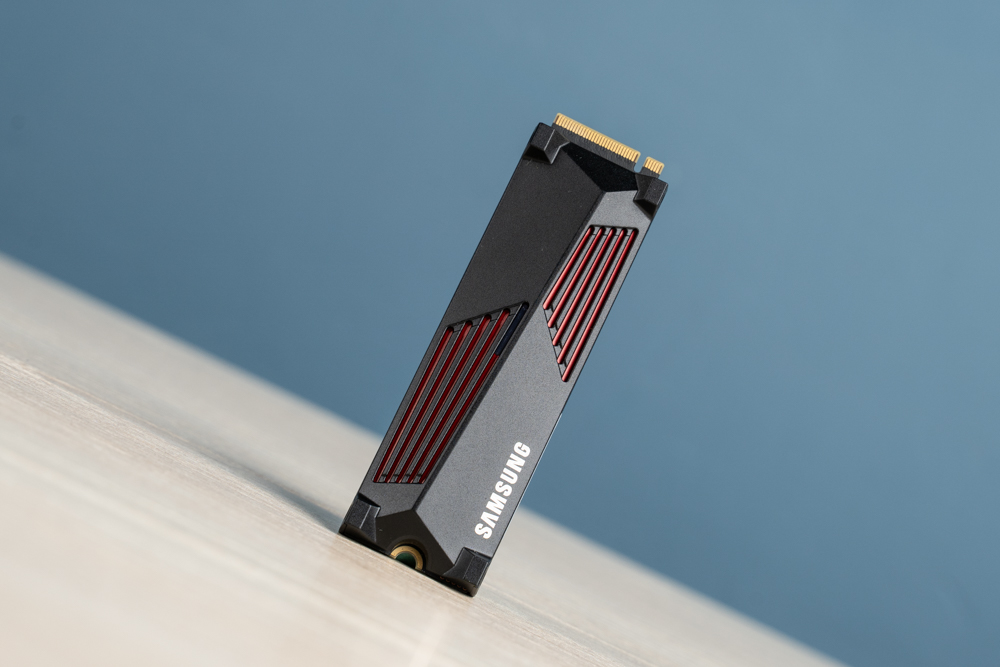
The Samsung 990 PRO with Heatsink SSD itself, is set against a contrasting background that emphasizes its modern and robust design. The heatsink is clearly visible with its distinctive red accent lines, which not only serve the functional purpose of dissipating heat but also add an aggressive aesthetic that appeals to gamers and performance enthusiasts. Samsung’s branding is prominent, reassuring users of the quality and reliability associated with the brand.
The angle of the photo gives a good view of the connector pins, showing that it’s ready to be installed into an M.2 slot on a compatible motherboard. The quality and finish of the product look excellent, and it seems to be a piece of hardware that would not only enhance the performance of a computer system but also its visual appeal if the motherboard setup is exposed, such as in a case with a transparent side panel.
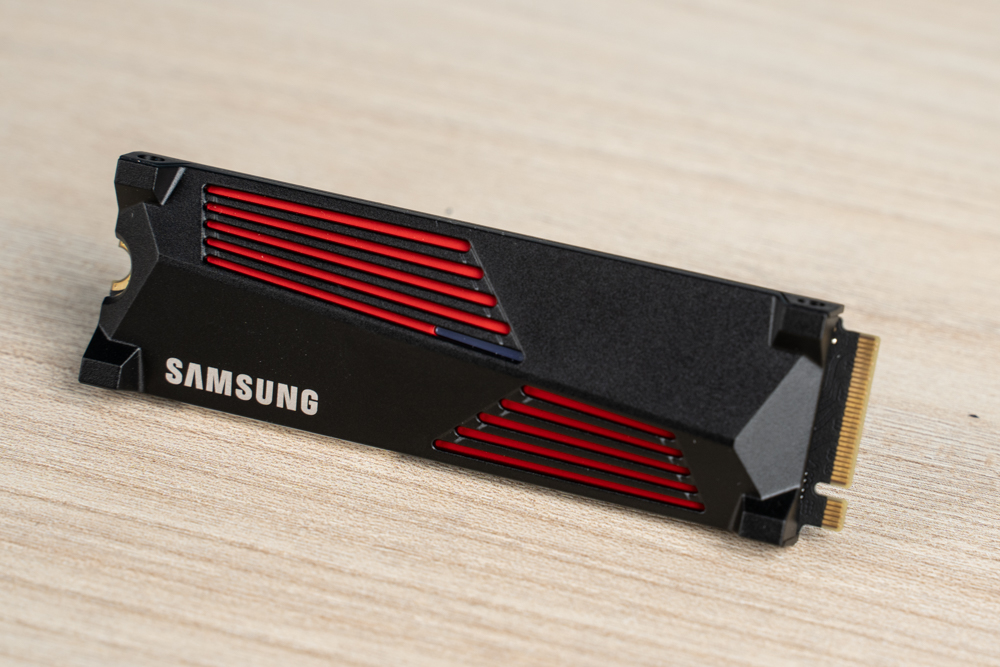
A closer view of the Samsung 990 PRO SSD with its striking heatsink adorned with red accent lines. The heatsink’s design is not only practical for dissipating heat efficiently but also adds a stylish, sporty look to the device, which can be particularly appealing to users who enjoy customizing their setups with visually distinctive components.
The SSD’s black and red color scheme is synonymous with high-end performance in computer hardware, often associated with gaming and high-power computing rigs. The Samsung branding is prominently displayed, signifying a mark of quality and reliability. With its bold design, this SSD is clearly aimed at users who prioritize both form and function in their tech choices.
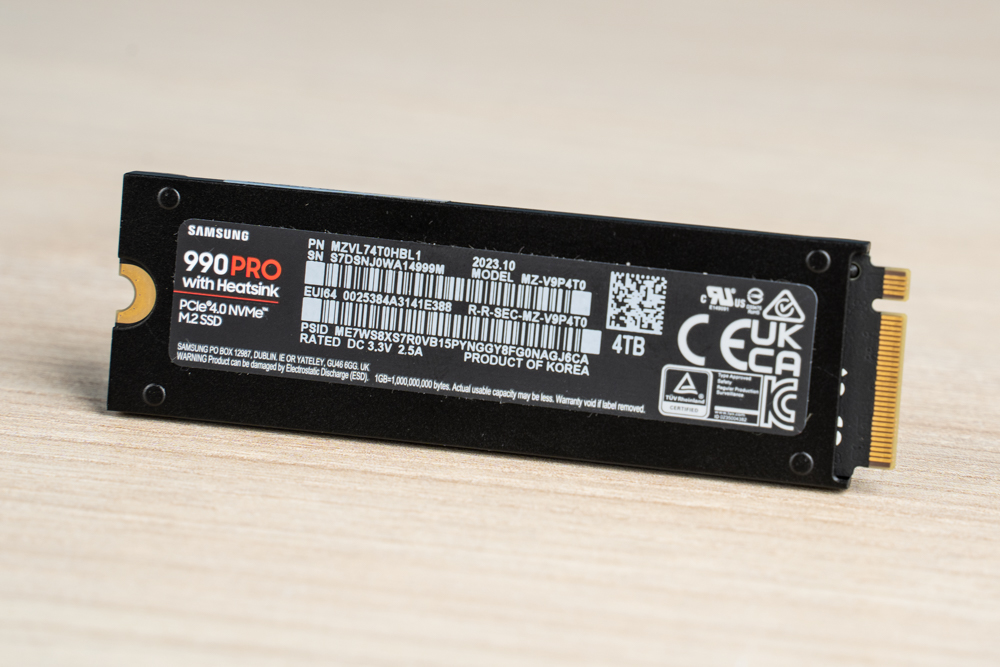
The backside of the Samsung 990 PRO SSD with Heatsink, where the label with all the detailed information is affixed. The label provides key details such as the model name, serial and part numbers, capacity (highlighting the substantial 4TB storage), and interface specifications (PCIe 4.0 NVMe M.2 SSD), which are critical for users during installation and support.
The label displays various certification icons, such as the CE mark indicating European conformity and the FCC mark for compliance with the Federal Communications Commission standards in the United States. There’s also a reminder of the product’s Korean origin, which speaks to the manufacturing standards associated with the region’s technological products.
This detailed labeling is an essential aspect of the product as it provides users with assurance of quality, regulatory compliance, and authenticity, which are particularly important for warranty and support services. The SSD’s adherence to various international standards is key for global compatibility and safety assurance.
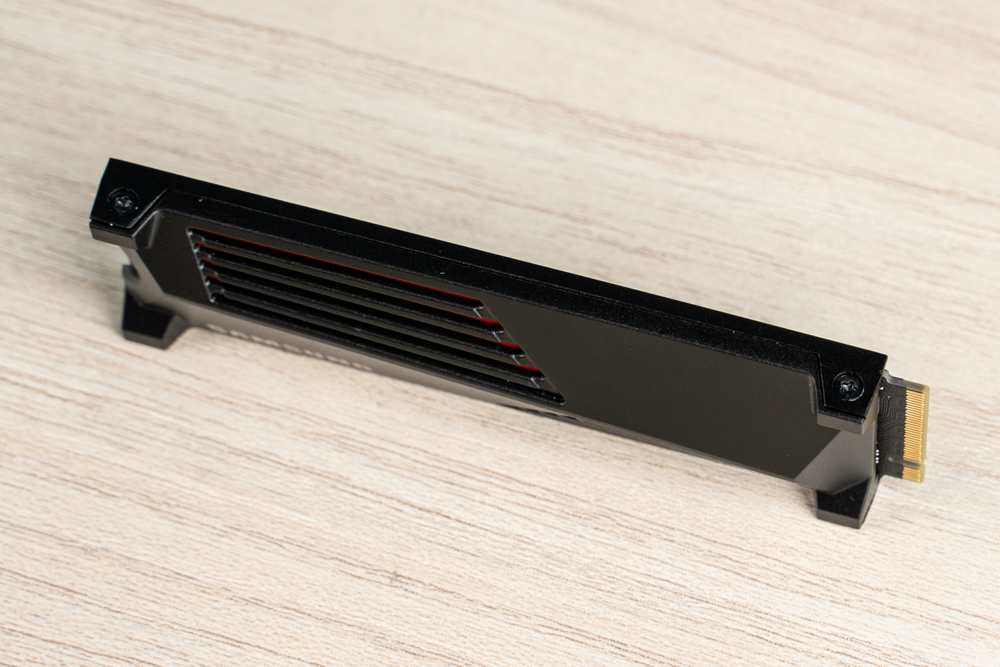
We see the side profile of the Samsung 990 PRO SSD with its heatsink. The heatsink is secured with four screws on the sides, a common method for ensuring a stable attachment that enhances thermal contact for efficient heat dissipation. The design suggests a sturdy construction, intended to keep the SSD within safe operating temperatures, which is especially important for maintaining performance and longevity under high workloads.
The image also implies that removing the heatsink would void the warranty, which is a standard practice with many electronic components. Manufacturers often use warranty seals or warnings like this to ensure that their products are not tampered with, which could potentially cause damage or affect performance. Users are advised to heed these warnings to maintain their warranty coverage. This is a vital consideration for consumers, as it informs them about the consequences of custom modifications and the importance of following the manufacturer’s guidelines to preserve their rights under the warranty terms.
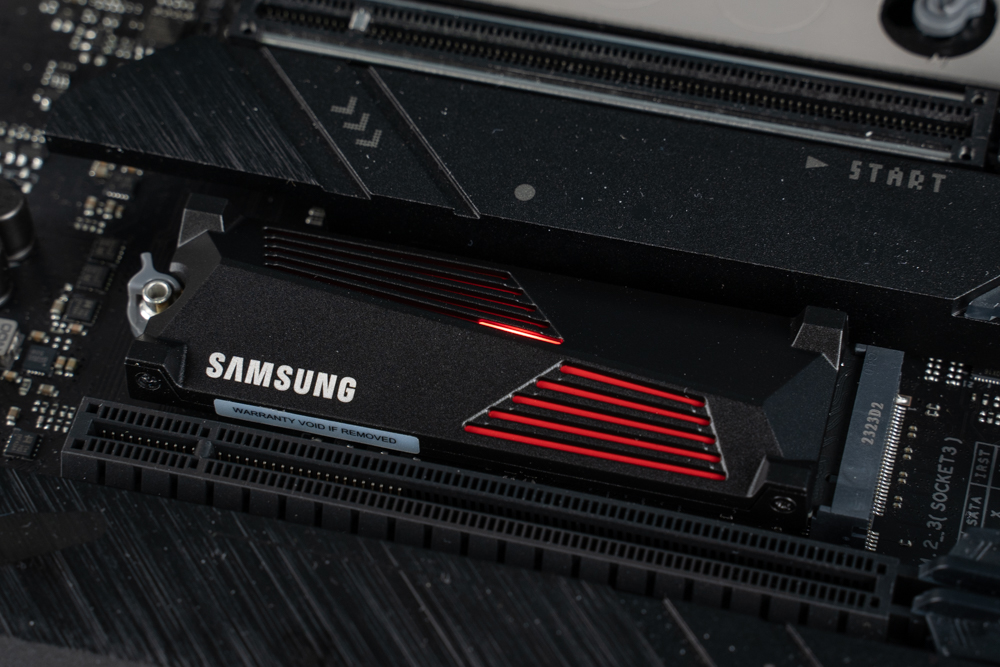
The Samsung 990 PRO SSD with Heatsink is shown installed in a motherboard slot, neatly fitting into its M.2 connector. The standout feature here is the RGB lighting accents, which add a touch of customizable color to the device, a popular trend in modern PC builds that adds visual interest and personalization to the hardware setup.
The subtle lighting coming through the red accent lines on the heatsink can often be controlled and synchronized with the system’s overall lighting scheme through compatible software, likely the Samsung Magician software in this case. This feature is not only for aesthetic appeal but is also a reflection of the user’s style, often coordinated with other RGB components within the PC.
It’s worth noting how the SSD fits into the overall build, showing compatibility and design consideration that allows it to blend seamlessly with the rest of the computer components. The “Warranty Void if Removed” label is also visible, which is a standard message indicating that tampering with the device could void the manufacturer’s warranty. This is a reminder to users to take caution and possibly seek professional assistance when thinking about making any modifications or attempting repairs.
Unboxing the Samsung 990 PRO with Heatsink: Exploring Advanced Features with Samsung Magician Software
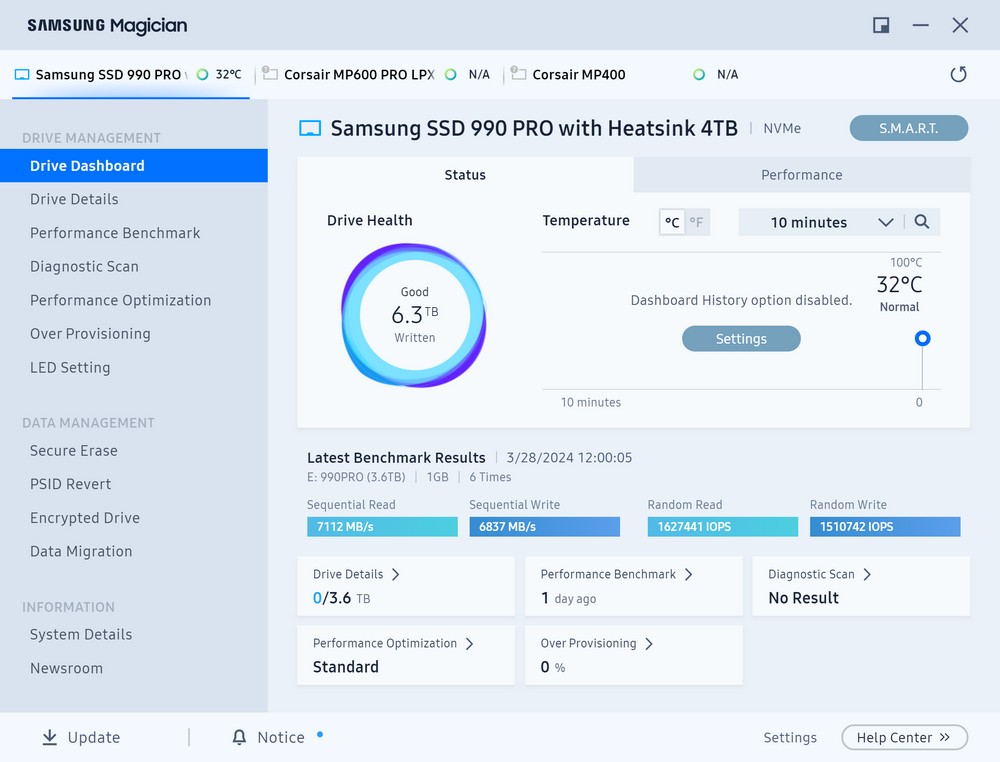
The user interface of the Samsung Magician software, which is a comprehensive utility for managing and optimizing Samsung solid-state drives (SSDs). This screenshot provides a view of the basic information and functionalities available for a Samsung 990 PRO with Heatsink SSD.
Key features highlighted within the Samsung Magician software include:
- Drive Dashboard: This section offers a quick overview of the SSD’s status, displaying drive health and temperature, and allows the user to access various management tools like performance benchmarking and diagnostics.
- Performance Benchmark: The user can see the latest benchmark results with impressive sequential read and write speeds, as well as random read and write IOPS (Input/Output Operations Per Second), which measure the drive’s performance under random data requests.
- Drive Health: This circular graphic indicates the SSD’s health status as ‘Good’ and shows the total data written to the drive, in this case, 6.3TB.
- Temperature Monitoring: The SSD’s temperature is displayed, showing a current measurement of 32°C, which is well within normal operating ranges, and significantly below the threshold of 100°C.
- LED Setting: An additional feature for this SSD model is the LED lighting customization, which allows users to adjust the RGB lighting on their SSD, further personalizing their PC build.
This software is an all-in-one suite that assists users in maintaining their SSD’s performance, health, and security. The combination of performance optimization, diagnostic scans, secure erase, and data management options, including encryption and migration tools, makes it a robust application for SSD management. The integrated LED lighting settings are a bonus for those who value aesthetics alongside performance in their computing environment.
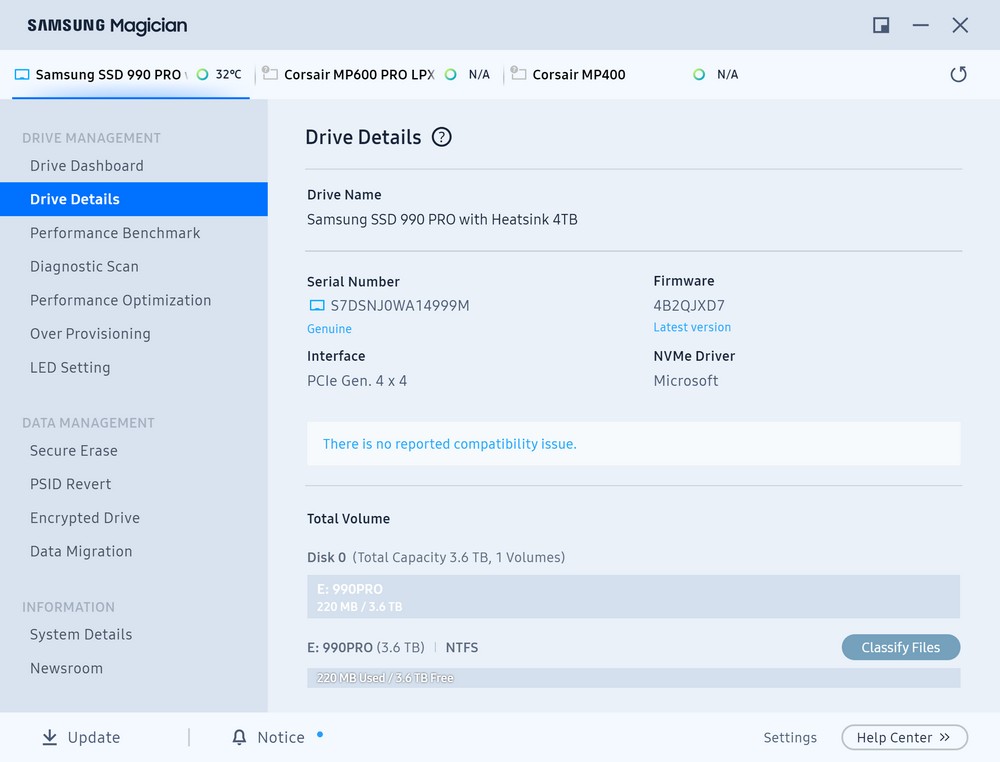
The image shows the Samsung Magician software’s “Drive Details” page for a Samsung 990 PRO with Heatsink 4TB SSD. It includes various pieces of information and tools for managing the SSD:
- Drive Name: Clearly displays the model of the SSD, which in this case is the Samsung 990 PRO with Heatsink 4TB.
- Serial Number: A unique identifier for the SSD, verifying its authenticity as a genuine Samsung product.
- Interface: Indicates the connection interface, which is PCIe Gen. 4 x4, offering high-speed data transfer capabilities.
- Firmware: Shows the firmware version currently installed on the SSD, with the notation that it is the latest version, indicating that the drive is up to date.
- NVMe Driver: Specifies that the SSD is using the standard Microsoft NVMe driver.
- Compatibility Issue: Notably, it is mentioned that there is no reported compatibility issue, suggesting that the SSD is functioning well within its current system environment.
- Total Volume: Provides details on storage capacity usage, displaying the total capacity and the amount of space used versus free space.
The Samsung Magician software is a user-friendly tool that allows users to monitor and maintain the health and performance of their Samsung SSDs. The detailed view here is especially useful for ensuring that the SSD firmware is up to date, which is essential for performance, security, and compatibility. Regular firmware updates can also deliver new features and optimizations that enhance the SSD’s functionality over time.
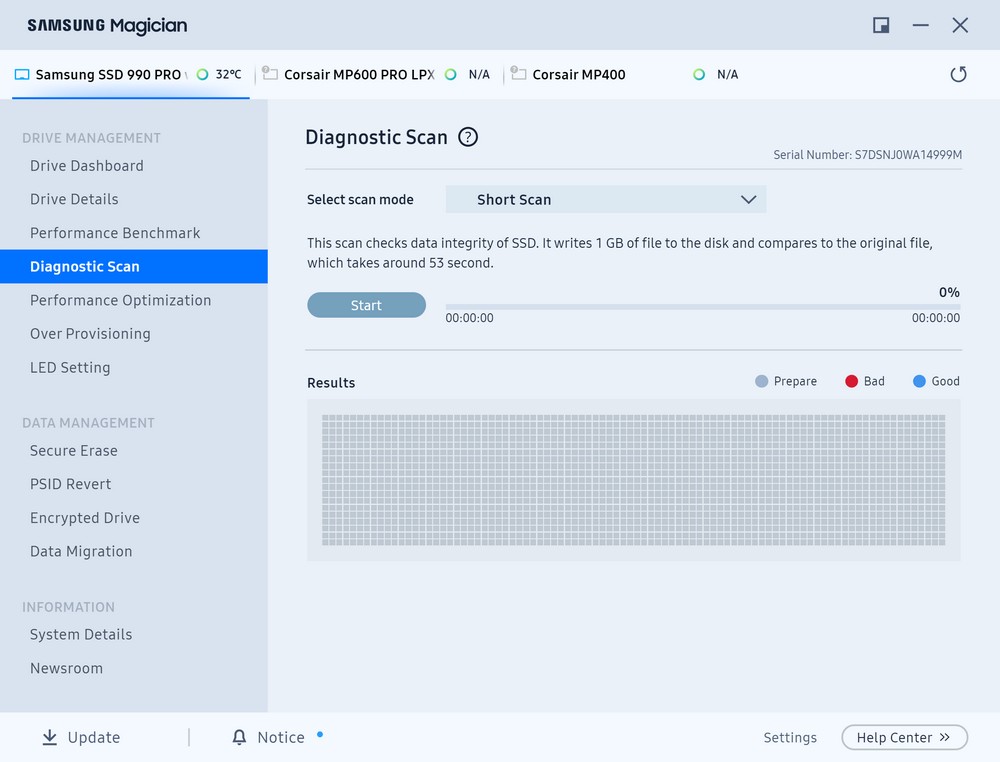
The “Diagnostic Scan” feature within the Samsung Magician software is specifically designed for the Samsung SSD 990 PRO. This tool is used to check the data integrity of the SSD by writing a 1GB file to the disk and then comparing it to the original file to detect any potential errors. It’s a short scan mode that typically takes 53 seconds to complete.
The scan appears to be ready to start, as indicated by the “0%” progress and “00:00:00” timer, with the “Start” button available for the user to initiate the process. Once the scan is running, results will populate in the grid under “Results,” with indicators for “Prepare,” “Bad,” and “Good,” allowing the user to easily assess the SSD’s health. This kind of diagnostic is important for early detection of potential issues that might affect data integrity or drive performance.
It’s a valuable tool for maintaining the SSD, as it helps ensure the storage device’s longevity and reliability. Regular scans can inform users about their SSD’s condition, allowing for timely interventions if any issues are detected.
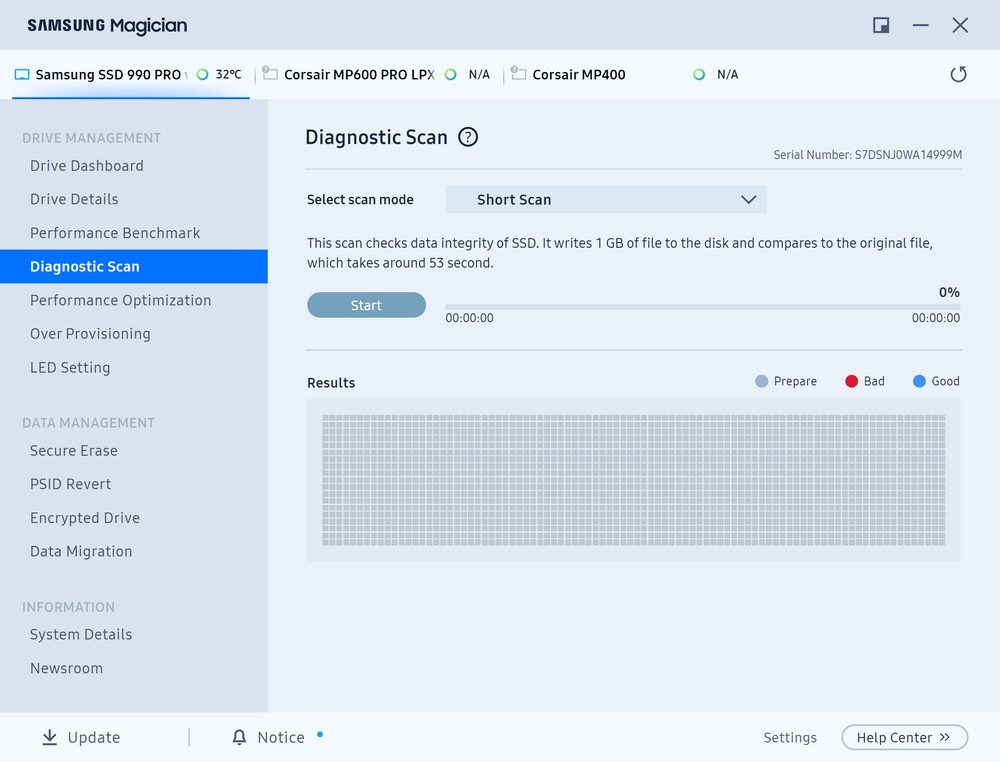
A continuation of the Samsung Magician software interface, but contrary to the caption provided, it doesn’t display the LED lighting settings. Instead, it showcases the “Diagnostic Scan” module again. If you were looking for information on the LED lighting settings for the Samsung SSD 990 PRO with Heatsink, typically, these settings would allow you to customize the RGB lighting of the SSD, enabling you to choose different colors or effects that can match the overall aesthetic of your computer setup.
The LED settings are usually found within a dedicated section of the Samsung Magician software, which provides the user with the options to personalize their hardware lighting. The lighting effects can often be synchronized with other components in a PC that also have RGB capabilities, creating a cohesive and visually appealing system. If you need to access these settings, you would look for a tab or option within the Samsung Magician software labeled ‘LED Setting’ or similar.
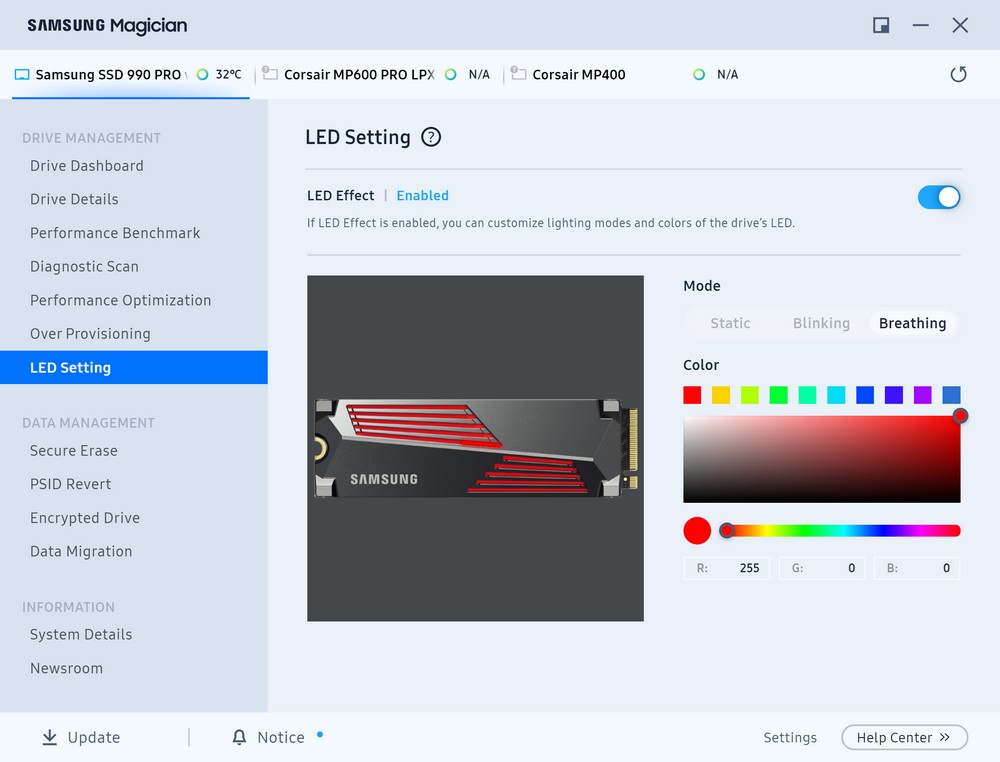
The “LED Setting” section within the Samsung Magician software, which allows users to customize the RGB lighting on their Samsung SSD 990 PRO with Heatsink. Here, you can see the different customization options provided by the software:
- LED Effect: Users can enable or disable the LED lighting according to their preference.
- Mode: There are different lighting modes available, such as “Static,” where the light remains constant, “Blinking,” where it flashes on and off, and “Breathing,” where the light intensity increases and decreases gently to create a breathing effect.
- Color: Users have a spectrum of colors to choose from, along with sliders to adjust the individual red, green, and blue (RGB) components to achieve the exact desired hue. The example shown in the software is set to red, with the RGB values of 255, 0, 0.
The accompanying image within the interface displays a preview of the SSD and illustrates where the RGB lighting is situated on the hardware. This feature allows users to match their SSD’s lighting with the rest of their system’s components or to set a specific color scheme that fits their personal style or mood. Contrary to the caption provided, this is not related to data encryption but is purely for adjusting the aesthetics of the SSD’s physical appearance.
Samsung 990 PRO 4TB SSD Benchmark Analysis: Pushing the Limits with Intel i9-14900K and ROG Strix Z790-E
The test setup features a high-end configuration with an Intel i9-14900K processor and an ROG Strix Z790-E GAMING WIFI II motherboard. The Samsung SSD is installed in an M.2 slot directly linked to the CPU, utilizing the full capabilities of a PCIe 4.0 x4 interface.
Here are some key points about the setup and each component’s role in performance:
- Intel i9-14900K: This is one of Intel’s top-tier processors, likely part of their Core i9 series, which is known for high performance, multiple cores, and threads that can handle intensive tasks and multitasking with ease.
- ROG Strix Z790-E GAMING WIFI II Motherboard: A motherboard that’s geared towards gamers and performance enthusiasts, featuring advanced connectivity options, including M.2 slots that support the latest PCIe 4.0 standard, which offers high bandwidth for faster data transfer speeds.
- M.2 CPU Direct Connect: By connecting the SSD directly to lanes provided by the CPU rather than through the chipset, the setup can minimize latency and maximize the throughput of the PCIe 4.0 x4 interface, offering the best possible performance for the SSD.
- PCIe 4.0 x4 Interface: This refers to the fourth generation of PCI Express with a four-lane configuration, allowing for higher data transfer rates compared to previous generations, and is particularly beneficial for storage devices like NVMe SSDs that can utilize the increased bandwidth.
With this configuration, the Samsung SSD is expected to deliver its top performance, showcasing its high read/write speeds and responsiveness, making this setup suitable for demanding applications such as gaming, video editing, and data analysis. The use of Samsung Magician software would complement this by enabling drive optimization, performance monitoring, and firmware updates, ensuring the SSD operates at its peak.

The information provided is a summary of the testing platform used to evaluate the performance of the Samsung 990 PRO SSD with Heatsink. Here are the key components of the test setup:
- Processor (CPU): Intel Core i9-14900K, a high-performance chip ideal for demanding tasks and benchmarks.
- Motherboard: ROG Strix Z790-E GAMING WIFI II, which includes an M.2 slot that operates over a direct CPU link, providing fast data transfer rates through a PCIe 4.0 x4 interface.
- Memory (RAM): T-Force Delta RGB DDR5-7200 24GBx2, providing a high-speed and sizeable memory capacity to support the processor in data-intensive tasks.
- Storage: CORSAIR MP600 PRO LPX 1TB as the system drive and SAMSUNG 990 PRO with Heatsink 4TB as the test drive.
- Power Supply Unit (PSU): LEADEX VII 1000W, which ensures stable and sufficient power delivery to all components.
- Operating System: Windows 11 Pro 23H2, the latest iteration of Microsoft’s OS, which can affect SSD performance due to its features and optimizations.
The screenshot shows the Windows properties for the Samsung 990 PRO 4TB SSD, indicating that after formatting, the actual available storage space is 3.63TB. This is common because the advertised capacity of an SSD (or any storage device) is always slightly higher than the usable space, due to the way operating systems calculate a terabyte and the need for file system structures which occupy some of the drive’s capacity.
This robust setup is suitable for testing the high-speed capabilities and features of the Samsung 990 PRO SSD, including the effectiveness of its heatsink and potential for overclocking or heavy usage scenarios, such as gaming or professional content creation.
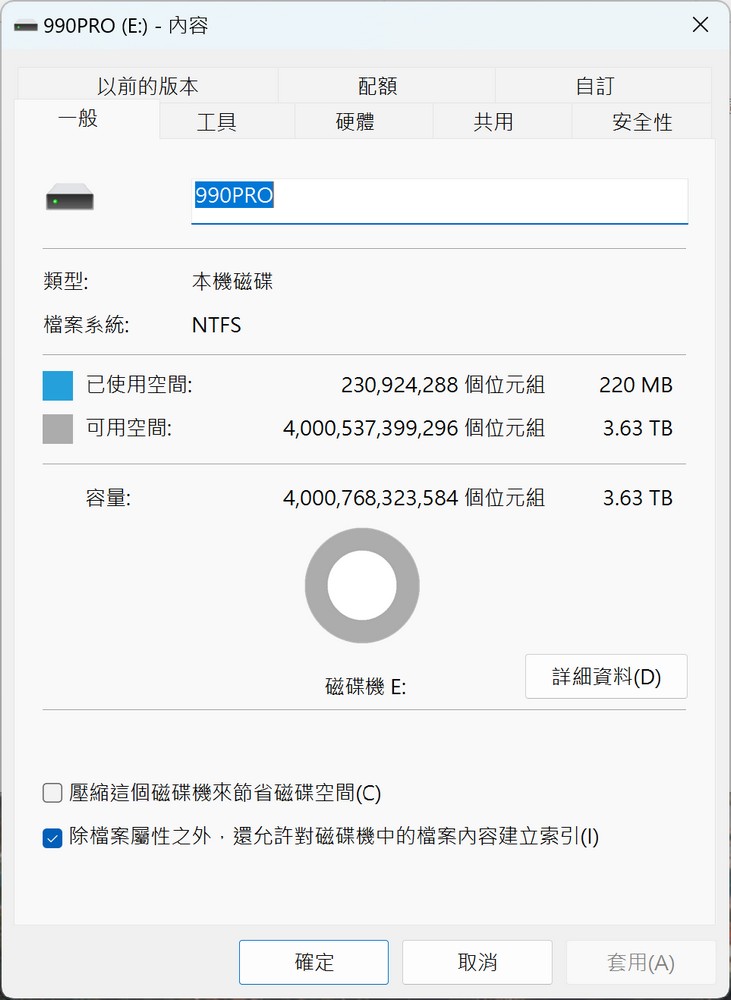
A snapshot from CrystalDiskInfo, a utility tool for monitoring the health and specifications of SSDs and other storage devices. Here, it details the status of the Samsung 990 PRO 4TB SSD with Heatsink:
- The SSD’s capacity is recognized as 4000.7 GB.
- The firmware version is noted as 4B2QJXD7, which is up to date.
- It confirms that the SSD is operating on a PCIe 4.0 x4 interface, which ensures fast data transfer rates.
- It supports NVMe 2.0 specification, indicating it can deliver high performance.
- The health status is marked as “Good (100%)”, which is ideal.
- The drive’s temperature is reported at 38°C, which is a safe operational temperature, especially for a high-performance drive.
CrystalDiskInfo is a helpful tool for users to confirm their storage device’s capabilities, health status, and operating conditions, assisting in the overall maintenance and longevity of the device.
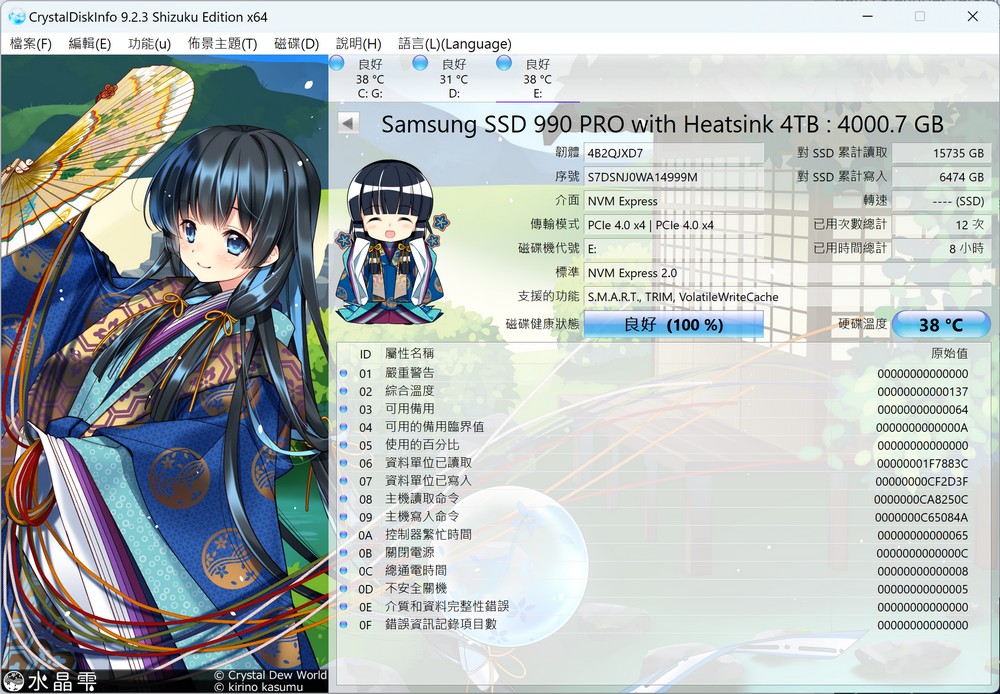
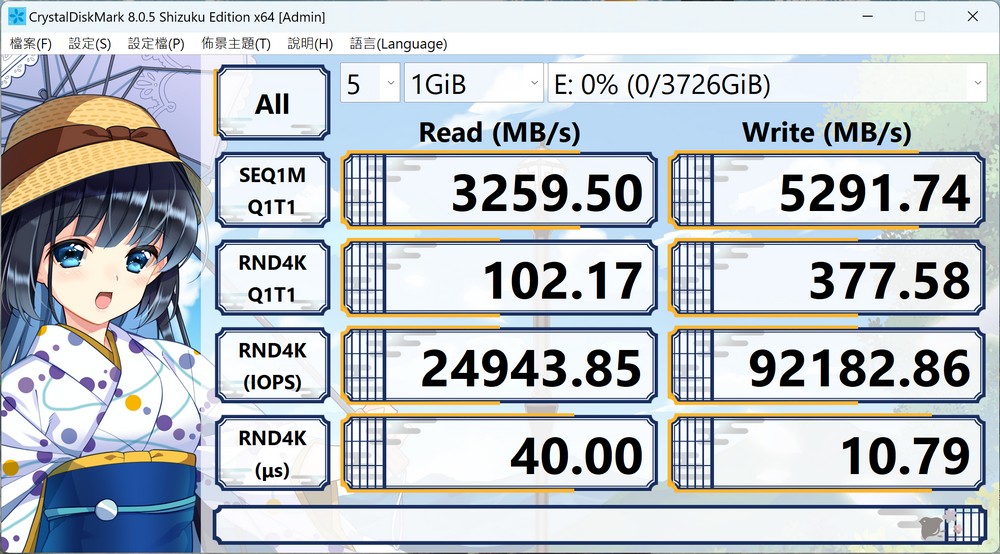
The two images show the results of CrystalDiskMark benchmark tests on a Samsung 990 PRO 4TB SSD. These tests measure the drive’s performance under different conditions:
- Best Performance Profile with NVMe Mode:
- Sequential Read (Q8T1): 7118.65 MB/s
- Sequential Write (Q8T1): 6878.61 MB/s
- Random Read (4KiB Q32T16): 6649.60 MB/s
- Random Write (4KiB Q32T16): 6366.07 MB/s
- Random Read (4KiB IOPS): 1623436 IOPS
- Random Write (4KiB IOPS): 1554217 IOPS
- Random Read/Write Latency (4KiB μs): 305.33 / 326.71 μs
- Real-World Performance Profile:
- Sequential Read (Q1T1): 3259.50 MB/s
- Sequential Write (Q1T1): 5291.74 MB/s
- Random Read (4KiB Q1T1): 102.17 MB/s
- Random Write (4KiB Q1T1): 377.58 MB/s
- Random Read (4KiB IOPS): 24943.85 IOPS
- Random Write (4KiB IOPS): 92182.86 IOPS
- Random Read/Write Latency (4KiB μs): 40.00 / 10.79 μs
These results showcase the impressive performance capabilities of the Samsung 990 PRO 4TB SSD, particularly in sequential read and write operations. The drive’s performance reflects its suitability for tasks requiring high-speed data transfer, such as video editing, gaming, and large data processing.
The differences in sequential read and write speeds between the “best performance” and “real-world” profiles could be due to a number of factors, including differences in queue depth and thread count settings, which simulate different types of workloads. The “best performance” settings are likely optimized for maximum throughput under ideal conditions, while the “real-world” settings simulate more common usage scenarios.
Overall, the SSD demonstrates that it can handle intensive workloads with ease, making it an excellent choice for users seeking top-tier storage solutions.
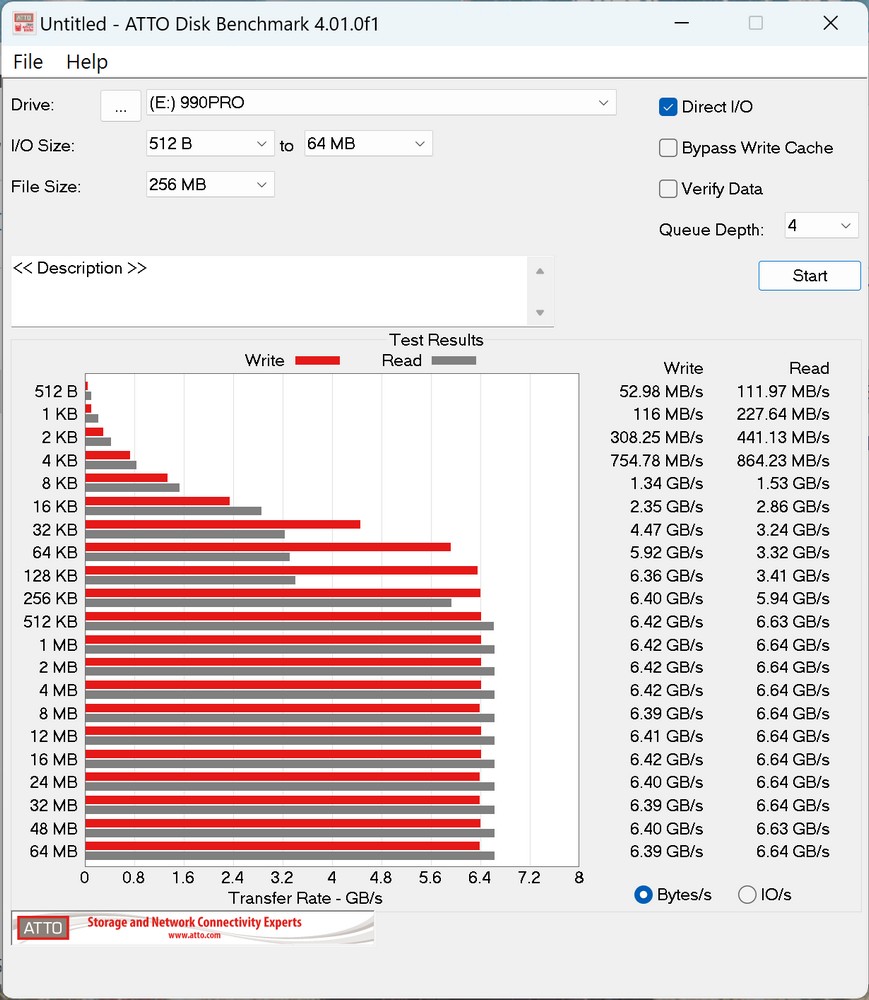
The ATTO Disk Benchmark results for the Samsung 990 PRO 4TB SSD. ATTO Disk Benchmark tests the performance of storage devices by using various I/O sizes, ranging from 512 bytes to 64 megabytes. This particular test was conducted with a queue depth of 4, which can affect performance outcomes as it represents the number of I/O operations queued at a time.
From the graph, we can observe:
- At smaller I/O sizes (512 bytes to 8 KB), the read and write speeds are relatively lower. This is typical because small, random I/O operations are generally more demanding and slower due to higher overhead.
- As the I/O size increases, the performance improves significantly, showcasing the SSD’s ability to handle larger chunks of data more efficiently.
- The SSD reaches its peak performance at larger I/O sizes, with the maximum read speed hitting around 6.64 GB/s and the maximum write speed at approximately 6.42 GB/s. These speeds are indicative of the high throughput capabilities of the Samsung 990 PRO SSD when dealing with large files, which is beneficial for applications like video editing, large-scale data analysis, and gaming.
The ATTO Disk Benchmark is a widely used tool for measuring the data transfer rates of hard drives and SSDs, and these results validate the Samsung 990 PRO’s robust performance characteristics, especially at higher data transfer sizes. The test results demonstrate that the SSD can deliver impressive speeds that leverage the bandwidth provided by the PCIe 4.0 interface.
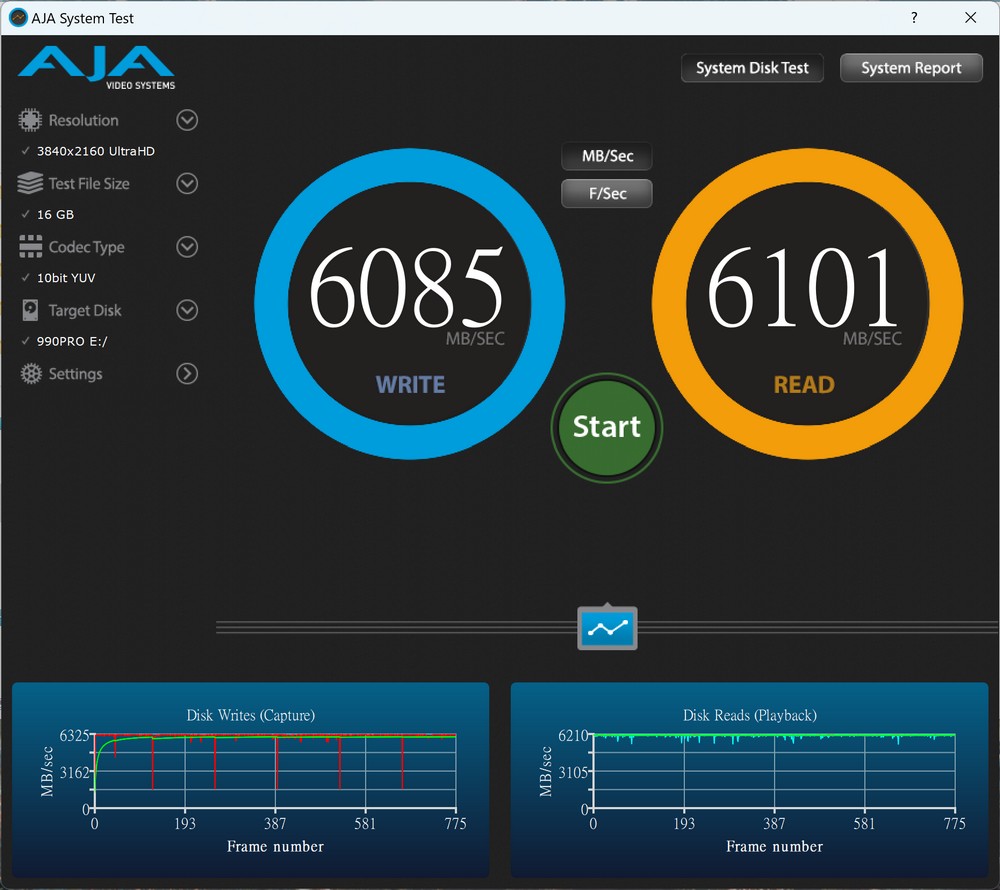
The results from the AJA System Test, a benchmarking tool used to simulate video multimedia workflows by testing the read and write performance of storage devices under conditions that mimic real-world video workloads.
For this test, the settings were configured to replicate a demanding video environment:
- Resolution: 3840×2160 UltraHD, which requires high bandwidth due to the large file sizes associated with 4K content.
- Test File Size: 16 GB, ensuring the test is large enough to be representative of typical 4K media files.
- Codec Type: 10bit YUV, a high-quality video format that is often used in professional video production.
The Samsung 990 PRO 4TB SSD achieved write speeds of 6085 MB/s and read speeds of 6101 MB/s. These speeds are exceptional and reflect the SSD’s capability to handle high-resolution video tasks, such as editing and rendering, which can be extremely data-intensive.
These results demonstrate that the Samsung 990 PRO SSD is well-suited for professionals in the video production and multimedia fields, where the ability to quickly read and write large video files is crucial. The SSD’s performance can significantly reduce the time spent on transferring and loading content, thereby streamlining the workflow for editing and production tasks.
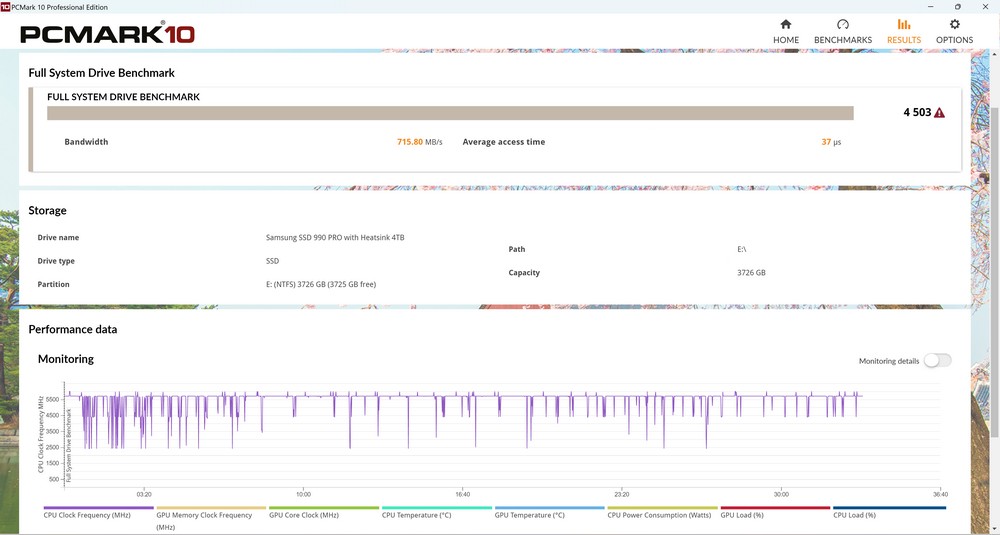
The results of the PCMark 10 Full System Drive Benchmark, a comprehensive tool that assesses the performance of a storage device under common use scenarios that a typical user might experience.
The PCMark 10 benchmark simulates a range of everyday tasks including booting up, starting various Adobe applications, operating Office software, and transferring files. This provides a broad measure of the drive’s capabilities, offering insights into how it might perform in a real-world context, rather than just testing its raw transfer speeds.
For the Samsung 990 PRO with Heatsink 4TB SSD, the benchmark produced the following results:
- Score: 4503, which is an overall indication of the drive’s performance in the context of PCMark 10’s testing criteria.
- Average Bandwidth: 715.8 MB/s, which shows the drive’s data transfer rate across all tested tasks. This is an important metric for understanding how quickly the drive can move data during everyday usage.
- Average Access Time: 37 microseconds, reflecting the speed at which the drive can access data. Lower access times are typically better as they contribute to faster system responsiveness.
These results demonstrate that the Samsung 990 PRO is not only capable of high-speed performance in sequential read/write tests but also performs excellently in a variety of common use cases. A score of 4503, along with the average bandwidth and access time shown, would generally be considered very good for a consumer SSD, indicating that it should provide a responsive and swift experience for most users and applications.
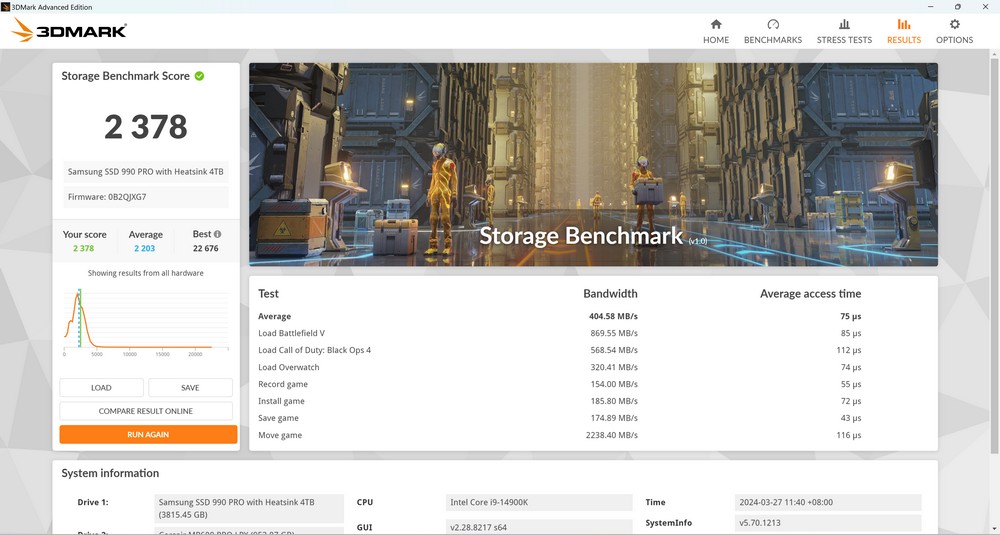
The screenshot showcases the results from the 3DMARK Storage Benchmark, a test designed to evaluate the performance of storage devices by simulating gaming-related tasks.
The benchmark assesses several gaming scenarios, such as:
- Loading games like Battlefield V and Call of Duty: Black Ops 4.
- The speed of game installation.
- The performance during recording gameplay.
- The time taken to save game progress.
The Samsung 990 PRO 4TB SSD has scored:
- 2378 points on the 3DMARK Storage Benchmark measure how well the storage performs in gaming scenarios relative to other drives.
- Average Bandwidth: The test reports an average bandwidth of 404.58 MB/s. This indicates the speed at which data is transferred during the test scenarios, which, for gaming purposes, involves reading game assets from the storage device into memory.
- Average Access Time: The SSD showed an average access time of 75 microseconds, a metric that reflects the time taken by the drive to respond to read and write requests.
These results may seem lower than the raw performance data from sequential read/write tests. However, gaming workloads are generally more complex with a mix of small and large file operations, which explains why the average bandwidth in gaming scenarios might be lower than the peak sequential transfer rates.
Overall, the score and the detailed bandwidth and access time metrics from the 3DMARK Storage Benchmark demonstrate that the Samsung 990 PRO is well-equipped to handle the demands of modern gaming which can greatly benefit from the speed and responsiveness of high-quality SSDs like this one.

A snippet from HWiNFO, a diagnostic and monitoring tool that provides in-depth hardware information and real-time system monitoring. The data presented is from a temperature test conducted using AIDA64 Linear Write, which stresses the SSD by continuously writing data until full capacity is reached—a process often referred to as a “torture test”.
Here are the details from the test for the Samsung 990 PRO SSD:
- Drive Temperature Sensors:
- Sensor 1 reached a maximum of 76°C with an average of 58°C.
- Sensor 2 reached a maximum of 76°C with an average of 58°C.
- Sensor 3 reached a maximum of 86°C with an average of 61°C.
- Drive Health:
- The SSD’s remaining life and available spare capacity are 100%, indicating no issues with drive health or space.
- Drive Reliability:
- No failures or warnings are reported, suggesting the drive operates reliably under the current conditions.
- Data Written and Read:
- The total host writes are 6,474 GB, and the total host reads are 7,824 GB, reflecting the drive’s usage.
The higher temperature recorded by Sensor 3 may be due to its location on the SSD, possibly near components that generate more heat or areas with less effective heat dissipation. However, an 86°C peak under maximum stress testing is not unusual for high-performance SSDs, especially during a rigorous task like a full-disk write. It’s important to note that such extreme conditions are unlikely during typical everyday usage, and the SSD should operate at much lower temperatures, particularly given its heatsink design aimed at improving thermal management.
While such tests provide valuable information about the thermal performance and potential thresholds of the SSD, the device’s behavior under common usage scenarios is generally more relevant to typical consumers. Nonetheless, users who plan to subject their SSDs to intensive workloads over extended periods should ensure good case ventilation and possibly consider additional cooling solutions to maintain optimal operating temperatures.
Summarize
The Samsung 990 PRO with Heatsink establishes itself at the forefront of PCIe 4.0 x4 SSDs thanks to its superior read and write speeds and robust random I/O performance. Its energy efficiency contributes to effective heat management. The heatsink, a standout feature in terms of design, not only adds an element of aesthetic flair but also delivers commendable thermal performance, making it an ideal choice for motherboards without built-in heatsinks or for enhancing the PS5 gaming setup. However, for those whose motherboards are already equipped with a heatsink, opting for the version without an additional heatsink may be advisable to avoid potentially voiding the warranty by removing it.
As mentioned earlier, the 990 PRO with Heatsink is particularly suited for installation in the PS5, especially with the growing storage demands of modern games like “Final Fantasy VII Rebirth” and “Yakuza 8.” The top-tier 4TB model offers ample storage space, effectively alleviating any concerns about capacity limits and making it an excellent time to upgrade to a new SSD. This SSD is a strong contender for those looking to boost their system’s storage performance in both gaming consoles and PCs.
If this article is helpful for you, please share this article with your friends on social media. Thank you!
This article is based on the personality of the reviews. You are responsible for fact-checking if the contents are not facts or accurate.
Title: Maximize Your Gaming Experience with the SAMSUNG 990 PRO SSD: The Ultimate Upgrade for PC and PS5